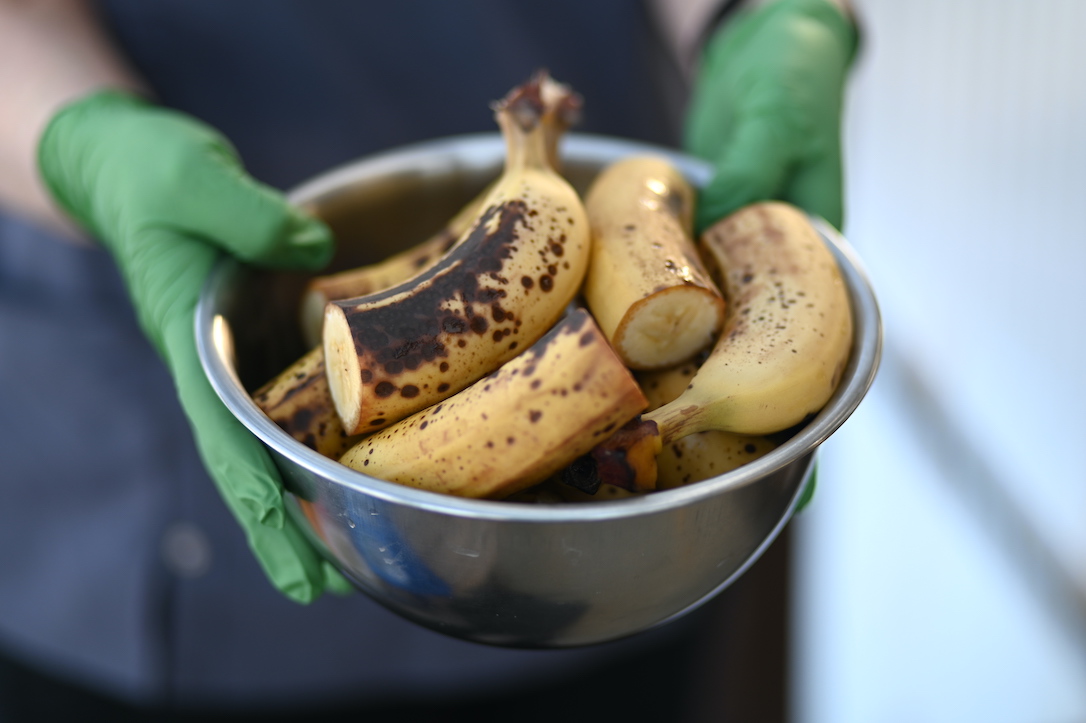Today’s blog is dedicated to our favorite fruit: bananas. Humans first domesticated these plants on the island archipelagos of Southeast Asia between 10,000 and 6,500 years ago. Ancient voyagers carried these remarkable berries with them around the globe, cementing their status as a staple crop for people living in tropical Africa, Asia, Oceania, and eventually the Americas.
Cavendish bananas are now the most popular cultivar worldwide despite actually being less than two-hundred years old. Bundles of these green bananas are shipped to regional warehouses where they are ripened in sealed rooms, resulting in the artificial yellow color that appeals to consumers in grocery stores. (Without the intermediate step, most Cavendish bananas will go from green to rotten without ever “ripening.”)
Besides simply cultivating and eating them, we humans have cemented a place for this fruit in pop culture. We refer to historically colonized nations as “Banana Republics,” laugh at people slipping on banana peels, and wear stupid banana costumes to parties. Spectacularly, people even began to include bananas in online images to provide the viewer with a sense of scale. (In fact, bananas may be a better unit of measurement than stoats.)
For a CSNW example, here’s an image of a Troll Doll (banana for scale):
Somehow, we also learned to associate bananas with our nonhuman ape and monkey relatives. (Thanks a lot, Donkey Kong!) As much as sanctuary caregivers may resent this overdone stereotype as we work hard to give the residents a wide variety of species-appropriate foods, even we cannot deny that chimpanzees really do love bananas. In fact, we almost always have them in stock as each chimp eats an average of one or two bananas each day. The reliance on bananas is normal for sanctuaries. At fellow NAPSA member sanctuary Chimp Haven, the enthusiasm with which each of their 300+ residents demands two bananas each morning has inspired a line of merchandise (and I have one of the mugs).
Note: The following meme depicts a young spider monkey, not a chimp, but it holds the same weight:
Fortunately for the sanctuary’s ten chimpanzee residents, we recently received an unexpected donation of bananas from the faith-based FISH Community Food Bank in nearby Ellensburg. Thanks, FISH!!!
The bananas were perfect– canary yellow with coffee-colored spots, firm but not starchy, and pungently sweet- and the generous people at the food bank gave us SEVEN CASES of these things to dole out to the chimps.
As Diana pointed out yesterday, the event was not quite a lagniappe, but it had a similar vibe. As a nonprofit organization, we rely on generosity and thoughtfulness to keep the sanctuary running. Every contribution matters. To make sure that we wouldn’t waste a donation like this, the staff got to work freezing peeled and blended bananas for use in future smoothies, dehydrating bananas to make chips for night bags, and washing bananas for immediate meal service. Processing new produce is one of my favorite weekly tasks, so this past week has been quite the thrill.
The chimps have not been complaining about receiving bananas more frequently. They demand their bananas first (because fruit is always the highest priority) then scarf them down with gusto. Lately, I’ve been trying to get a passable photo of any chimpanzee eating a donated banana to send to the team at the food bank, but the chimpanzees eat them too fast and I miss each narrow window of opportunity.
This pattern continued through today. During breakfast, I stood in front of the indoor enclosures and waited for the chimps to bring their bananas in from the Greenhouse (just as Jody did on Friday). They all inhaled their first course on the spot instead of taking it to go, so I squandered that chance by planning poorly. Then, at dinner, the bananas were almost entirely gone by the time I had carried out my other duties and arrived in the Greenhouse with a camera.
I did manage to salvage a few photos from breakfast, however. In particular, Jamie was overwhelmed by the amazing banana smoothie that the care team had prepared for both groups of chimps. She used her fingers to scrape every last bit of it from the plastic cup.
After breakfast, Jamie finally went into the indoor rooms and sat on a bench. I still had the camera hanging from my neck, so I asked her if I could take some portraits. She mostly ignored me (except for an occasional nod that I interpreted as “affirmative”), and kept looking over my shoulder. Her attention evidently went down the hall toward the kitchen. I turned to follow her gaze. Through that narrow doorway, we could both see straight through to the transparent refrigerator door where hundreds of bananas sat on brightly-lit shelves.
I doubt that Jamie knows the natural history of bananas or that the people at FISH supplied us with the ones she ate for breakfast, but it’s a safe bet that she’ll be expecting one on her breakfast tray tomorrow morning.
She’s in luck.
We have, like, a thousand of them.
P.S. If you’re interested in helping us to get fresh produce to the chimps every day, you should consider being a Produce Patron!
















